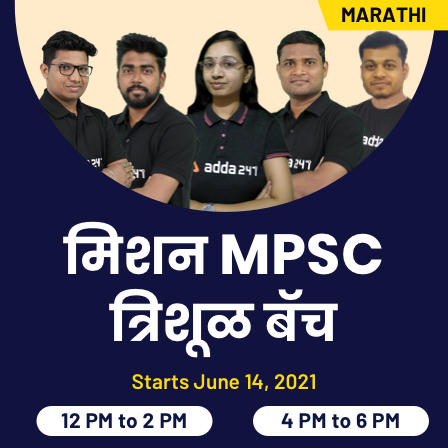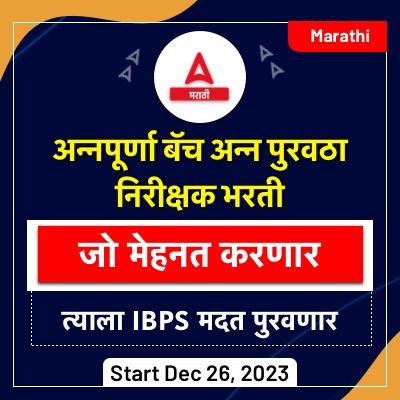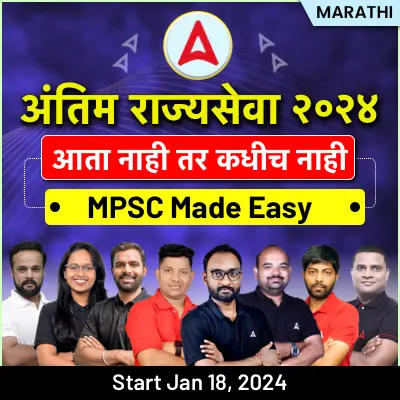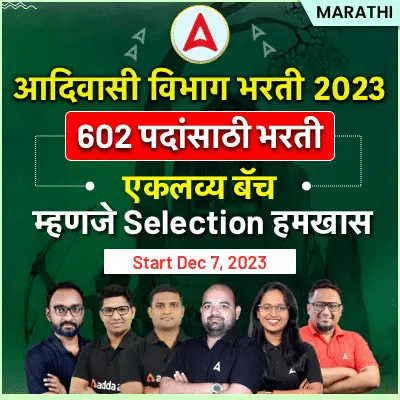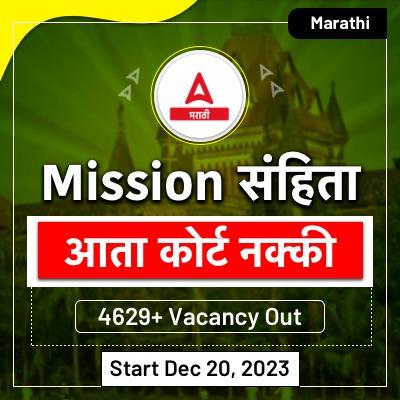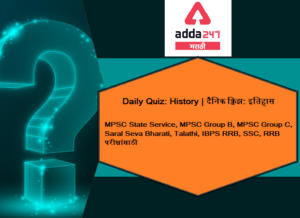
इतिहास दैनिक क्विझ मराठीमध्ये: 31 मे 2021
महाराष्ट्र राज्य लोकसेवा आयोग दरवर्षी वेगवेगळ्या परीक्षे मार्फत हजारो विद्यार्थ्यांची भरती करून घेते MPSC State Service, MPSC Group B, MPSC Group C, Saral Seva Bharati, Talathi, UPSC, SSC, RRB अशा अनेक परीक्षांमार्फत हजारो जागांची भरती दरवर्षी निघते ज्यात लाखो इच्छुक हजार किंवा त्याहूनही कमी जागांसाठी अर्ज करतात. आपण एमपीएससी आणि इतर परीक्षाची तयारी करत असाल तर आपल्याला क्विझ देण्याचे महत्त्व माहित असलेच पाहिजे. बर्याच विद्यार्थ्यांना अभ्यासाचे पुरेसे तास दिले जात असतानाही त्यांना या परीक्षांची पूर्तताही करता आली नाही कारण ते त्यांचे परीक्षण वेळेवर पूर्ण करू शकत नाहीत आणि संशोधन करण्याचा उत्तम मार्ग म्हणजे त्या संबंधित विषयाची किंवा विषयाची क्विझ देणे कारण आपण या मार्गाने कव्हर करू शकता कमी वेळात जास्तीत जास्त विषय. आम्हाला Add 247 मराठी येथे चांगल्या अभ्यास सामग्रीचे मूल्य समजले आहे आणि म्हणूनच आम्ही सर्व विषयांसाठी आपल्याला क्विझ प्रदान करीत आहोत. दैनिक क्विझ देऊन तुम्ही तुमच्या तयारीची पातळी तपासू शकता.
चालू घडामोडी, भूगोल, अर्थशास्त्र, पर्यावरण, सामान्य विज्ञान, इतिहास, पॉलिटी अशा सर्व स्पर्धात्मक सामान्य अभ्यास विषयांमध्ये इतिहासाचाही महत्वाचा वाटा आहे. तर चला इतिहास बद्दल तुमची तयारी तपासण्यासाठी खालील 31 मे 2021 ची इतिहासाची दैनिक क्विझ पहा.
Q1 सामंत, जमींदारी कार्यकाळ आणि सावकार आणि वन कंत्राटदारांनी केलेल्या शोषणाच्या विरोधात बिरसा मुंडा (1860 -1920) ला ___________ चे पाठबळ होते.
(a) कोल उठाव
(b) पहारीस ’बंड
(c) चुर उठाव
(d) उलगुलान उठाव
Q2. खालीलपैकी कोणता नेता खोंड विद्रोहांशी संबंधित होता-
(a) चिट्ठीर सिंह
(b) गोविन्द गुरु
(c) चक्र बिसोई ,
(d) तोम्मा सोरा
Q3.कोया बंड्यांबद्दल खालील विधानांचा विचार करा
1. कोया, आधुनिक काळातील तमिळनाडू येथे या बंडाची सुरुवात झाली
2. या बंडाचे कारण म्हणजे पोलिस आणि सावकारांकडून होणारा अत्याचार, नवीन नियम आणि
वनक्षेत्रांवरील त्यांचे प्रथागत अधिकार नाकारणे.
वर दिलेली कोणती विधाने बरोबर आहेत?
(a) 1 फक्त
(b) 2 फक्त
(c) दोघी 1 आणि 2
(d) 1 किंवा 2 नाही
Q4. भिल्ल बंडखोरीची पुढील कारणे कोणती
1. आर्थिक त्रास
2. दुष्काळ
3. त्यांचे किल्ले नष्ट करणे
योग्य कोड निवडा:
(a) 1 आणि 2
(b) 2 आणि 3
(c) 1 आणि 3
(d) फक्त 1
Q5. रॅमोसिस या पश्चिम घाटाच्या टेकड्या जमातींनी ब्रिटीशांच्या राजवटीशी आणि ब्रिटीश प्रशासनाच्या पध्दतीशी समेट केला आणि त्यांच्या नेतृत्वात संघटनेच्या धोरणाला त्यांनी नापसंती दर्शविली.
(a) चिट्ठीर सिंह
(b) गोविन्द गुरु
(c) चक्र बिसोई
(d) तोम्मा सोरा
Q6. आसाममध्ये खालीलपैकी कोणते बंड आहेत?
1. आहोम् उठाव
2. खासीस उठाव
3. सिंगफोस बंड
योग्य कोड निवडा:
(a) 1 आणि 2
(b) 2 आणि 3
(c) 1 आणि 3
(d) फक्त 1
Q7. 1928 च्या नेहरू अहवालासंदर्भात खालील विधानांचा विचार करा?
1. कोणताही धर्म नसलेले भारत धर्मनिरपेक्ष राज्य केले पाहिजे.
2. मुस्लिम अल्पसंख्याक आहेत अशा प्रांतांमध्ये मुस्लिमांसाठी स्वतंत्र मतदार दिले जावेत.
3. सार्वत्रिक प्रौढ मताधिकार दिला पाहिजे.
4. त्यात एकोणीस मूलभूत अधिकार दिले.
वर दिलेली कोणती विधाने बरोबर आहेत?
(a) 1, 2 आणि 3
(b) 2,3 आणि 4
(c) 1,3 आणि 4
(d) वरील सर्व
Q8. लखनौ कॉंग्रेस अधिवेशन 1916 च्या संदर्भातील खालील विधानांचा विचार करा?
1. अध्यक्षस्थानी अंबिका चरण मजूमदार हे होते
2. टिळक यांच्या नेतृत्वात कॉग्रेसच्या पटसंख्येच्या नियंत्रणाने पुन्हा एकदा पाठपुरावा केला.
3. कॉंग्रेसने स्वतंत्र मतदारांविषयी मुस्लिम लीगची भूमिका स्वीकारली नाही.
वर दिलेली कोणती विधाने बरोबर आहेत?
(a) 1, 2 आणि 3 फक्त
(b) 2 आणि 3 फक्त
(c) फक्त 1
(d) एकही नाही
Q9. “रक्त आणि लोह” चे धोरण यांच्याशी संबंधित आहे:
(a) बाबर
(b) बालबान
(c) तैमूर
(d) क़ुतुबुद्दीन ऐबक
Q10. अमीर खुसरो यांचे शिक्षक खालीलपैकी कोण मानले जाते?
(a) मोईनुद्दीन चिश्ती
(b) निजामुद्दीन औलिया
(c) बख्तियारपुर काकी
(d) एकही नाही
महाराष्ट्र राज्यातील सर्व स्पर्धा परीक्षांचे मोफत अभ्यास साहित्य
YouTube channel- Adda247 Marathi
App- Adda247 (मराठी भाषा)
Use Coupon code: HAPPY
आणि मिळवा 75% डिस्काउंट
आता तुमच्या घरी लाइव्ह वर्ग मराठीत उपलब्ध आहेत
केवळ सरावच परीक्षेत चांगले गुण मिळण्यास मदत करू शकतो
SBI लिपिक फाउंडेशन बॅच | द्विभाषिक
Solutions
S1.Ans.(d)
Sol.
the Mundas in the region south of Ranchi rose under Birsa Munda. The Ulgulan was one of the most significant tribal uprisings in the period 1860-1920. The rebellion which began as a religious movement gathered a political force to fight against the introduction of feudal, zamindari tenures, and exploitation by money-lenders and forest contractors. The Mundas claimed Chhotanagpur as their area in 1879. British armed forces were then deployed. Birsa was captured and imprisoned.]
S2.Ans.(c)
Sol.
Khond Uprisings (1837-1856) From 1837 to 1856, the Khonds of the hilly tracts extending from Odisha to the Srikakulam and Visakhapatnam districts of Andhra Pradesh revolted against Company rule. Chakra Bisoi, a young raja, led the Khonds who were joined by the Ghumsar, Kalahandi, and other tribals to oppose the suppression of human sacrifice, new taxes, and the entry of zamindars into their areas. With Chakra Bisoi’s disappearance, the uprising came to an end.
S3.Ans.(b)
Sol.
Koya Revolts The Koyas of the eastern Godavari track (modern Andhra), joined by Khonda Sara chiefs, rebelled in 1803, 1840, 1845, 1858, 1861, and 1862. They rose once again in 1879-80 under Tomma Sora. Their complaints were oppression by police and moneylenders, new regulations, and denial of their customary rights over forest areas. After the death of Tomma Sora, another rebellion was organized in 1886 by Raja Anantayyar.
S4.Ans.(a)
Sol.
Bhil Revolts The Bhils who lived in the Western Ghats controlled the mountain passes between the north and the Deccan. They revolted against Company rule in 1817-19, as they had to face famine, economic distress, and misgovernment. The British used both force and conciliatory efforts to control the uprising. However, the Bhils revolted again in 1825, 1831, and 1846. Later, a reformer, Govind Guru helped the Bhils of south Rajasthan (Banswara, Sunth states) to organize themselves to fight for a Bhil Raj by 1913.
S5.Ans.(a)
Sol.
Ramosi Risings The Ramosis, the hill tribes of the Western Ghats, had not reconciled to British rule and the British pattern of administration. They resented the policy of annexation. After the annexation of the Maratha territories by the British, the Ramosis, who had been employed by the Maratha administration, lost their means of livelihood. They rose under Chittur Singh in 1822 and plundered the country around Satara
S6.Ans.(c)
Sol.
Movements Before 1857 1. Ahoms’ Revolt (1828-33; Assam); against the non-fulfillment of the pledges of the Company after the Burmese War; the uprising was suppressed by the Company by dividing the kingdom. 2. Khasis’ Revolt (the 1830s; hilly region between Jaintia and Garo Hills); led by the Nunklow ruler, Tirath Singh; against the occupation of the hilly region. 3. Singphos’ Rebellion (1830s; Assam); led to the murder of British political agent of Assam by Singphos in 1839; was ultimately suppressed
S7.Ans.(c)
Sol.
The constitution outlined by the Nehru Report was for Indians enjoying dominion status within
the British Commonwealth. Some of the important elements of the report:
∎ Unlike the eventual Government of India Act 1935, it contained a Bill of Rights.
∎ All power of government and all authority – legislative, executive, and judicial – are derived from the people and the same shall be exercised through organizations established by, or under, and in accord with, this Constitution.
∎ There shall be no state religion; men and women shall have equal rights as citizens.
∎ There should be a federal form of government with residuary powers vested in the center. (Some scholars, such as Moore 1988 considered the Nehru Report proposal as essentially unitary rather than federal);
∎ It included a description of the machinery of government including a proposal for the creation of a Supreme Court and a suggestion that the provinces should be linguistically determined.
∎ It did not provide for separate electorates for any community or weightage for minorities. Both of these were liberally provided in the eventual Government of India Act 1935. However, it did allow for the reservation of minority seats in provinces having minorities of at least ten percent, but this was to be in strict proportion to the size of the community.
∎ The language of the Union shall be Indian, which may be written either in Devanagari (Hindi/ Sanskrit), Telugu, Kannada, Marathi, Gujarati, Bengali, or Tamil in character. The use of the English language shall be permitted.
S8.Ans.(c)
Sol.
The 31st Session of the Congress was held at Lucknow in 1916. It was presided over by the Ambica Charan Majumdar who was a prominent lawyer and was actively associated with the Congress since its birth, finally readmitted the Extremists led by Tilak to the Congress fold.
After a lapse of about 10 years, both the Moderates and Extremists have united again which was a good sign for the national movement. In his address, the President declared ‘If the United Congress was buried at Surat it is reborn at Lucknow in the garden of Wajid Ali Shah. After nearly 10 years of painful separation and wanderings through the wilderness of misunderstandings, the brother had at first met brothers’. In this session the Congress and the
Muslim League came closer to each other and they signed the historic Lucknow Pact.
While the League agreed to present joint constitutional demands with the Congress to the Government, the Congress accepted the Muslim League’s position on separate electorates. Bal Gangadhar Tilak was a leader of extremists.
S9.Ans.(b)
Sol.
Balban utilized the policy of “blood and iron” to consolidate the Delhi sultanate. This policy implied being ruthless to the enemies, use of swords, harshness, and strictness, and shedding blood. It allowed the use of all sorts of methods of terrorism and inflicting violence upon enemies.
S10.Ans.(b)
Sol.
Amīr Khusrow Dehlavī, was a Sufi musician, poet, and scholar from India. He was an iconic figure in the cultural history of South Asia. He was a mystic and a spiritual disciple of Nizamuddin Auliya of Delhi. Khusrow is regarded as the “father of qawwali” (a devotional music form of the Sufis in the Indian subcontinent) and introduced the ghazal style of the song into India.

